|
|
The River Forts of Johor
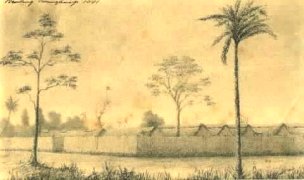 Melaka
was very much a maritime power, her fleets having absolute control of
the Straits along its entire length - from the coast of northern
Sumatra to the southernmost tip of the Malay Peninsula. This maritime
supremacy also enabled her Laksmanas or admirals - Melaka's highest
military rank - to dispatch troops rapidly to any part of its far flung
territories - either to repel invaders, as it did the Siamese, or to
mount conquests of its own on the Peninsula and across the Straits in
Sumatra. Melaka
was very much a maritime power, her fleets having absolute control of
the Straits along its entire length - from the coast of northern
Sumatra to the southernmost tip of the Malay Peninsula. This maritime
supremacy also enabled her Laksmanas or admirals - Melaka's highest
military rank - to dispatch troops rapidly to any part of its far flung
territories - either to repel invaders, as it did the Siamese, or to
mount conquests of its own on the Peninsula and across the Straits in
Sumatra.
However, the military prowess of the Malay was also formidable
on land. This is evident from not only the vast array (and quantity) of
artillery that Melaka employed but also from the importance in Malay
history and culture of the Malay fort. The Malay word for fort is
'kota' and it is no accident that the word also means 'large town' or
'city'. In fact, dozens of modern-day towns and cities in Malaysia
still have 'Kota' as the prefix in their names. These were not just
military stockades but were also administrative centres, seats of royal
government and hubs of commerce.
There is very early evidence of Malay forts in Kedah and
Perak, and Melaka itself was a heavily fortified city under the
Sultans. However, this fort-building tradition probably began in
earnest during the period of the Johor Empire. Pursued by the
Portuguese and facing relentless attacks by other powers such as Acheh,
the Johor Sultans built no less than eight forts along the whole length
of the Johor river. These were located from Sayong Pinang on the
river's watershed right down to Johor Lama and Kota Batu, more than 50
miles kilometres downstream, at the river's estuary.

Source: Kota-Kota Melayu, Abdul Halim Nasir,
1990, Dewan Bahasa dan Pustaka
After the fall of Melaka 1511, Sultan Mahmud set up
administrative centres at various parts of the remnants of his empire -
Muar, Pagoh, Bentan and, finally, Kampar in Sumatra. When he died there
in 1528, his successor Sultan Alauddin returned to Johor and set up his
administrative centre at Pekan Tua, about 11km upriver from modern Kota
Tinggi. Further downstream, he established a fort known as Kota Kara.
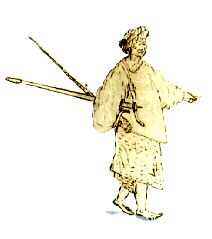 In
June 1535, two large galleons and a fleet of smaller vessels, under
Estavao da Gama, with 400 soldiers invaded Johor. He bombarded and
attacked Kota Kara but the Malays repulsed the assault. Portuguese
troops landed a few days later and shelled the fort from a neighbouring
hill, but even they had to retreat. Spurred by their initial success,
the Malays left their fortified ramparts and attacked the retreating
Portuguese. However, caught in a murderous crossfire out in the open,
the Malays were scattered and the Portuguese captured the abandoned
fort, burning it to the ground. In
June 1535, two large galleons and a fleet of smaller vessels, under
Estavao da Gama, with 400 soldiers invaded Johor. He bombarded and
attacked Kota Kara but the Malays repulsed the assault. Portuguese
troops landed a few days later and shelled the fort from a neighbouring
hill, but even they had to retreat. Spurred by their initial success,
the Malays left their fortified ramparts and attacked the retreating
Portuguese. However, caught in a murderous crossfire out in the open,
the Malays were scattered and the Portuguese captured the abandoned
fort, burning it to the ground.
Sultan Alauddin fled Pekan Tua and set up a fort further
upriver in Sayong Pinang He returned shortly to Kota Kara and re-built
it. However, Estavao da Gama attacked it again with 400 hundred
Portuguese soldiers and a force of Malay mercenaries. Sultan Alauddin
moved his capital to Johor Lama, nearer the Johor river estuary, and
built a fort at Kota Batu nearby, to guard the river approach to the
new capital.
Johor was threatened from another quarter in 1539, when Acheh
attacked Johor's vassal, Aru, with a fleet of 160 vessels, manned by
12,000 Achinese, Melaka Malays, Malabaris, Gujeratis, and even Turkish
soldiers. Sultan Alauddin mustered a fleet, with help from his allies
in Siak and Perak, and invaded Aru the next year. He recaptured it,
leaving only 14 of the invading Achinese vessels still afloat, and
thousands of Achinese troops dead on the field of battle. Called the
battle of Sungai Paneh, it was a glorious Malay victory, the most
significant and crushing since they were ousted from Melaka.
| In 1564, Johor was again at war with Acheh, who
attacked Kota Batu and Johor Lama. The fort and town were captured and
destroyed completely, with hundreds of cannon and artillery pieces
seized as booty. The Johor Sultan himself was captured and brought in
chains to Acheh, where he died shortly. The Achinese installed his son
as Sultan Muzaffah Shah and he rebuilt Kota Batu, ringing its walls
with cannon. However, in a move to assert his independence from his
conquerors and probably to erase all memory of the sack of Johor Lama,
Sultan Muzaffah moved his capital to Seluyut, 15km upstream near Kota
Tinggi. |
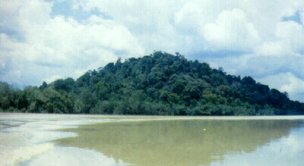
View of Bukit Seluyut, from the Johor
River. The fort at
Seluyut was located on the summit of the hill. Tun Sri
Lanang, the writer of the Sejarah Melayu, is reputed to
have been born here in 1565. Source: Kota-Kota
Melayu, Abdul Halim Nasir, 1990, Dewan Bahasa
dan Pustaka |
He died in 1571 and was succeeded by Sultan Ali Jalla Abdul
Jalil Shah II. Sultan Ali rebuilt Johor Lama and enlarged Kota Batu,
with a hill in the centre overlooking the ramparts and thick swamps and
impenetrable forests surrounding its perimeter, providing a natural
line of defence. He also introduced fortified citadels at strategic
points on the fort and equipped it with hundreds of cannon. With such
stout defences, Johor Lama quickly became a thriving centre of trade,
rivaling even Melaka. This worried the Portuguese and, in 1576, their
fleet attacked the fort but were beaten back. Another Portuguese fleet
attacked again in 1578 but a murderous bombardment from the fort's
ramparts set fires to and sank a number of their ships , and the
Portuguese again retreated in disarray.
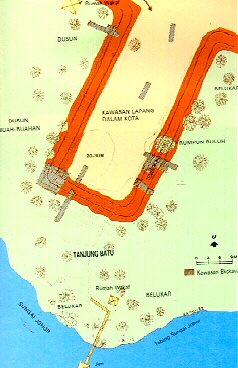
Plan of Kota Batu, on the Johor River.
Source: Kota-Kota Melayu, Abdul Halim
Nasir, 1990, Dewan Bahasa dan Pustaka
|
However, Johor's growing strength and independence over
the years began to annoy the Achinese, who still regarded themselves as
Johor's overlords. In 1582, they attacked Kota Batu and Johor Lama but
were beaten back. Ironically, the Johor Malays received help in the
form ships and troops from the Portuguese, who saw Acheh as a far
greater threat than Johor.
This dubious alliance was, however, predictably
shattered when in 1586 the Sultan, with a fleet of 100 vessels,
including 16 large galleys, besieged Melaka, the blockade causing great
famine in the town. The Johor Malays were later joined by Minangkabaus
from Naning and Rembau. A sortie by 100 Portuguese and 600 Malay
mercenaries, all equipped with firearams, encountered the 2000-strong
Minangkabau force and defeated them. Later, a Johor fleet of 120 ships,
led personally by the Sultan, sailed into the harbour and launched a
final assault. Sultan Abdul Jalil landed on one-side of the city ,
while his general Singaraja attacked the other, but both were beaten
back by 'A Famosa's' impregnable walls.
|
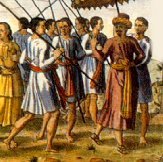 Antonio
de Noronha pursued the retreating Malays to the Johor river with a
fleet of galleons but his large, slow moving ships could do nothing
against the swift Malay galleys. The fleet pursuing was bombarded by
the cannons at Kota Batu. But the Portuguese were later reinforced with
fast, small galley and fustas, which repulsed an attack by 20 Malay
boats. After bombarding Kota Batu, the Portuguese landed a force of
about 300 men and assaulted it. The fort was bristling with cannons and
defended by about ten to twelve thousand Johor Malays, Minangkabaus,
Javanese, Terengganu Malays and allies from the vassal Sumatran states
of Indragiri and Kampar. The Portuguese attack was very easily thrown
back. A large landing party under the personal command of de Noronha
proceeded overland, by-passing the fort, and attempted to storm Johor
Lama. However, the Portuguese were yet again beaten back and they fled
to their ships, back to Melaka. Antonio
de Noronha pursued the retreating Malays to the Johor river with a
fleet of galleons but his large, slow moving ships could do nothing
against the swift Malay galleys. The fleet pursuing was bombarded by
the cannons at Kota Batu. But the Portuguese were later reinforced with
fast, small galley and fustas, which repulsed an attack by 20 Malay
boats. After bombarding Kota Batu, the Portuguese landed a force of
about 300 men and assaulted it. The fort was bristling with cannons and
defended by about ten to twelve thousand Johor Malays, Minangkabaus,
Javanese, Terengganu Malays and allies from the vassal Sumatran states
of Indragiri and Kampar. The Portuguese attack was very easily thrown
back. A large landing party under the personal command of de Noronha
proceeded overland, by-passing the fort, and attempted to storm Johor
Lama. However, the Portuguese were yet again beaten back and they fled
to their ships, back to Melaka.
Later that year, the Portuguese dispatched a much larger fleet
from Goa, India, and beseiged Kota Batu and Johor Lama. On August 15th,
they stormed the fort and town, capturing over 1000 bronze cannons,
1,500 muskets, 2,000 galleys and boats, and large amounts of gold and
silver. Determined to crush all resistance, the Portuguese ships raided
the entire length of the Johor River, destroying over 1200 Malay boats.
Sultan Ali retreated upstream and built yet another fort at Batu Sawar,
near Kota Tinggi. But the fort was quickly attacked by the Portuguese,
who captured it and seized 20 cannon.
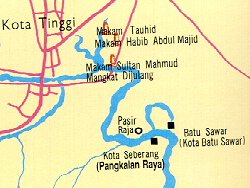
Source: Kota-Kota Melayu, Abdul Halim
Nasir, 1990, Dewan Bahasa dan Pustaka |
Johor seemingly vanquished forever, the Portuguese
returned to Melaka. However, Sultan Ali rebuilt the fort at Batu Sawar.
When he died in 1597, his son Sultan Alauddin Riayat Shah II assumed
the Johor throne. His cousin, Raja Abdullah was appointed Regent and he
constructed his own stout defences in a fort across the river from the
fort at Batu Sawar, called Kota Seberang ('Fort on the Other Side').
In September 1606, the Dutch admiral Matelief visited
Kota Batu Sawar and Kota Seberang. He recorded that the Batu Sawar fort
was protected by sharpened wooden stakes; about 12m high, around its
perimeter, and manned by about 3,000 to 4,000 armed soldiers.
|
Batu Sawar town itself had grown to become an important
trading centre, with Matelief recording a vibrant export of tin, ivory,
agarwood, pepper and other commodities. Imports from Portuguese,
English, Chinese, Indian and Arab merchants included rich silks,
porcelain, tea, tobacco and other goods.
 However,
Acheh was still at war with Johor and in 1613, the Achinese took the
opportunity of capturing this rich prize by sending an invasion fleet
led personally by its renowned Sultan, Iskandar Muda Mahkota Alam. The
seige lasted three months but the fierce resistance of the Johor Malays
was no match for the warlike Achinese. Both Sultan Alauddin and Raja
Abdullah were captured, and brought to Acheh together with most of the
Johor nobility, including the venerable Tun Seri Lanang, creator of the
'Sejarah Melayu'. Sultan Alauddin was restored to his throne in 1614,
but was later again attacked by the Achinese, who suspected him of
plotting alliances with their Dutch enemies. He was brought back to
Acheh and executed. However,
Acheh was still at war with Johor and in 1613, the Achinese took the
opportunity of capturing this rich prize by sending an invasion fleet
led personally by its renowned Sultan, Iskandar Muda Mahkota Alam. The
seige lasted three months but the fierce resistance of the Johor Malays
was no match for the warlike Achinese. Both Sultan Alauddin and Raja
Abdullah were captured, and brought to Acheh together with most of the
Johor nobility, including the venerable Tun Seri Lanang, creator of the
'Sejarah Melayu'. Sultan Alauddin was restored to his throne in 1614,
but was later again attacked by the Achinese, who suspected him of
plotting alliances with their Dutch enemies. He was brought back to
Acheh and executed.
Successive Sultans continued, at various times, to occupy Batu
Sawar as the seat of their governments up to the reign of Sultan Abdul
Jalil Shah III. During his reign, in 1673, an invasion fleet of 75 war
boats from the Sumatran kingdom of Jambi attacked and captured the fort
and capital. They carried off with them over 100,000 Dutch guilders and
over a hundred cannons, capturing 2,500 Malay soliders. The Sultan
managed to escape to Pahang, where he died, but Batu Sawar never again
became the Empire's capital - abandoned and forgotten up to today.
Write to the author: sabrizain@malaya.org.uk
The
Sejarah Melayu
website is
maintained solely by myself and does not receive any funding
support from any governmental, academic, corporate or other
organizations. If you have found the Sejarah Melayu website useful, any
financial contribution you can make, no matter how small, will be
deeply appreciated and assist greatly in the continued maintenance of
this site.
|
|

